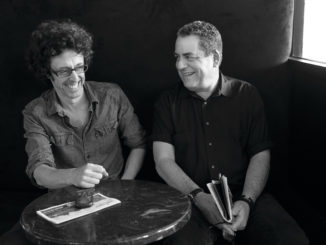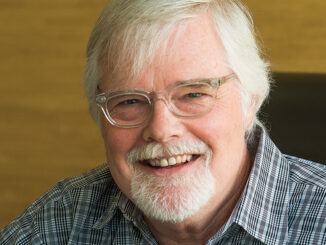
by Scott Collins
Alyson Dee Moore and Chris Moriana make quite a pair.
The duo are Foley artists who spend their days making the sounds of bodies falling, hubcabs spinning and glass breaking on a crowded soundstage on the Warner Bros. lot in Burbank.
Really, the stage, crowded with empty bottles, old spare parts and bric a brac of every description, looks more like a junkyard – and when that’s pointed out to them, they take it as a point of pride rather than an insult. That means Moore & Moriana have everything on hand to make the sounds that projects require for just the right level of authenticity.
Now they have been nominated for Emmys in two different categories, as part of the sound editing teams of HBO’s dark comedy “Barry” and CBS’ sci-fi extravaganza “Star Trek: Discovery.”
Excerpts follow:
CineMontage: How did you guys start working as a team?
Chris: I started working at Warners at night about five years ago, and Alyson’s partner from before, John Roesch, was leaving to go up north to Skywalker Sound.
Alyson: They built him a big Foley stage.
Chris: Which left a vacancy here. I started filling in occasionally with her during the day and we just kind of had this energy that worked. She asked me to be her partner one day.
Do Foley artists always work in teams?
Alison: Mostly. No. 1, it’s the workload.
Chris: Plus, I think there’s a good balance because if there’s any kind of eating, or vocal expression, anything that has to do with breathing or whatever, you can distinguish if it’s a man doing it, or a woman. We find a lot of supervisors like the combination of a man and a woman. It does sound better if a woman’s walking in high heels. It adds a little something.
Alyson: Yeah, we stay with that character the whole time. Chris is Barry. Every episode, that’s who Barry is.
Chris: I have shoes that are strictly for him, and I wear them every time. Every actor has a way that they walk. When somebody comes to a stop, I notice a lot of actors will stop and then do a little scuffle or a thing. Whatever.
It takes a little while, but we get into that character, and once you understand the way they move, you can do a better job. A lot of times they want this character to walk, but do it in a way that conveys sadness. Do it like they’re walking to the electric chair. “I want to hear that in your footsteps.” That’s what they say to us. Or if somebody’s drunk, you got to stagger, you’ve got to portray that.
CineMontage: How did each of you get into this line of work?
Alyson: We’re industry brats. My dad was an actor. He played Hank Kimball on “Green Acres.” I was born and raised here and I always thought I wanted to do something in film. I didn’t know what it was going to be. First, I wanted to be a music engineer. That was my passion, was music. My dad had a friend who was a sound editor and I thought, well, it’s sound. It’s editing. I thought, “There aren’t a lot of female engineers.” That was the first time I was ever introduced to a Foley stage, which was here at Warner Brothers. The editors did their own Foley but they called it syncing.
A a guy named Bill Wistrom hired me to sit actually on the Foley stage with the Foley artists and write out his cue sheets for the mix, for the dub, and I really got to see exactly what they did and why they did it and what was involved.
Chris: My father, Rocky Moriana, had a company called RM Productions. He worked for Aaron Spelling. He was in charge of music and all the effects for “Love Boat,” “Charlie’s Angel’s,” “Hart to Hart.” I’m one of four boys in my family and all of us ended up working for my dad. And eventually all of us got into the business. My oldest brother became a mixer. The brother just older than me is a music editor and still is to this day. I’m a Foley artist. My younger brother, Jimmy, was a Foley artist as well. He passed away about four years ago now.
I was working as an assistant editor for my dad’s company and I wanted to also get into music, so I was an assistant music editor. And my job was to run stuff back and forth to the scoring stage and pick stuff up and bring it back.
Eventually I started going with the editors to the Foley stage. I just went along for crowd scenes. So, that grew into a full time position as a Foley artist.
We both have performing backgrounds too. I wanted to be an actor at one time. You’ll find most Foley artists have a performance background. Over the years I have tried to do other things. I’ve sold real estate for a while and then, for some reason … this work is just like the Mafia. Just when you think you can get out …
Alyson: And it’s so nice to be in the union now. We got in in 2005. It really makes sense to be in 700.
Chris: Everyone we work with is involved with at 700. Kind of the same family.
What’s a typical work day like?
Chris: The sound editor makes up cue sheets for us, that has all the sounds they need.
Alyson: We make up a laundry list of things to do.
Chris: We’ll take the page and we’ll go out on the stage.
Alyson: We’ll do all the cell phones at once, and all the kitchen stuff at once. So, we’re organized.
Chris: We’ll go through and say, “Oh, I need a bottle, I need wrapping, I need this, I need that. Gather the stuff.”
Sometimes you get cues for someone’s finger on an iPhone screen. How on earth do you do that? Swiping your finger on a smartphone doesn’t make any noise!
Chris: I know. But this isn’t the real world. Sound editors and producers and sometimes directors want to hear stuff that isn’t audible a lot of times. So, we’ll just overplay it. Make it bigger.
Yesterday, we did hair. You know when you get your hair cut and it’s falling on the ground? We had to make the sound of it falling on the ground, because there was a shot, a close-up shot of the hair falling on the ground.
That’s our challenge, right?
How often does the sound editor send back sounds you made and say, “This isn’t what we want.”
Alyson: It usually happens in features, where maybe we made a choice that wasn’t their choice.
When we did “Crazy Rich Asians,” there was always one scene that came back and it was the dumpling scene, where they’re making dumplings. Talk about hard to make a sound out of something that doesn’t really make a sound, all that dough stuff. That kept coming back and coming back and coming back.
On the flip side, Chris did the whole scene at the end with the Mahjong tiles and those sounded beautiful, and that just went and never came back, so… You never know.
What specific challenges have you faced on “Star Trek: Discovery?”
Alyson: Because it’s sci-fi, certain things like the chairs have to sound high tech. So, they couldn’t rattle.
Chris: Make it make sound, but don’t make sound.
Alyson: But make it sound modern.
Chris: Make it stealthy. Yeah.
Alyson: But “Star Trek” also has a really defined surface of inside the space ship. The bridge has one surface, the hallway has another surface.
Chris: Private quarters have a separate surface.
Alyson: And all metal-type sounds.
Chris: Creating the sound for Saru, that was interesting. That was a new take on a character and it was a first for me. He’s got these hoof-like feet. So, it’s not your typical heel-toe kind of a walk. I have to just walk in these shoes that I made especially for him. It’s almost like a horse hoof.
I wear these particular shoes and I walk differently. I don’t walk like I would walk on a regular person, because he’s just basically almost walking on his toes. I have to make sure there’s no heel action.
Alyson: And it’s really hard for a Foley artist not to walk heel-toe.
Chris: Yeah. It goes against my natural inclination as a Foley artist.
The Creative Arts Emmys will be announced in ceremonies on Sept. 14 and 15, and air Sept. 21 on FXX.
Scott Collins is the Communications Director of Motion Picture Editors Guild.





